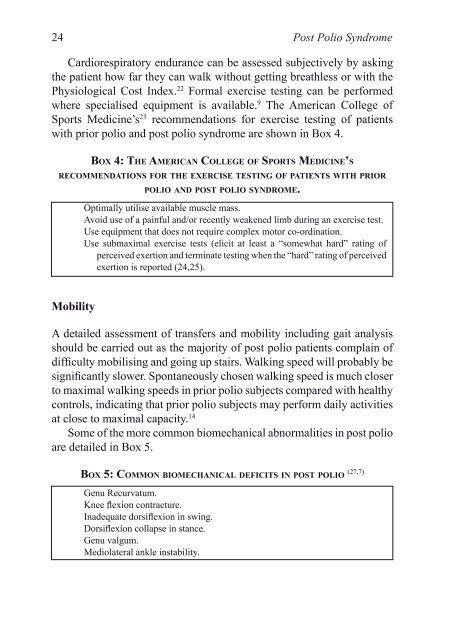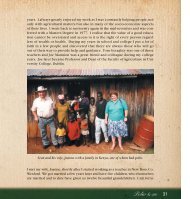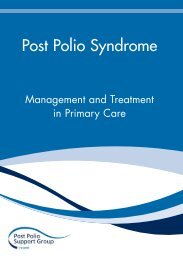Post Polio Syndrome - Management & Treatment in Primary
Post Polio Syndrome - Management & Treatment in Primary
Post Polio Syndrome - Management & Treatment in Primary
You also want an ePaper? Increase the reach of your titles
YUMPU automatically turns print PDFs into web optimized ePapers that Google loves.
24 <strong>Post</strong> <strong>Polio</strong> <strong>Syndrome</strong><br />
Cardiorespiratory endurance can be assessed subjectively by ask<strong>in</strong>g<br />
the patient how far they can walk without gett<strong>in</strong>g breathless or with the<br />
Physiological Cost Index. 22 Formal exercise test<strong>in</strong>g can be performed<br />
where specialised equipment is available. 9 The American College of<br />
Sports Medic<strong>in</strong>e’s 23 recommendations for exercise test<strong>in</strong>g of patients<br />
with prior polio and post polio syndrome are shown <strong>in</strong> Box 4.<br />
box 4: the ameriCan College oF sPorts mediC<strong>in</strong>e’s<br />
reCommendations For the exerCise test<strong>in</strong>g oF Patients with Prior<br />
<strong>Polio</strong> and <strong>Post</strong> <strong>Polio</strong> syndrome.<br />
Mobility<br />
Optimally utilise available muscle mass.<br />
Avoid use of a pa<strong>in</strong>ful and/or recently weakened limb dur<strong>in</strong>g an exercise test.<br />
Use equipment that does not require complex motor co-ord<strong>in</strong>ation.<br />
Use submaximal exercise tests (elicit at least a “somewhat hard” rat<strong>in</strong>g of<br />
perceived exertion and term<strong>in</strong>ate test<strong>in</strong>g when the “hard” rat<strong>in</strong>g of perceived<br />
exertion is reported (24,25).<br />
A detailed assessment of transfers and mobility <strong>in</strong>clud<strong>in</strong>g gait analysis<br />
should be carried out as the majority of post polio patients compla<strong>in</strong> of<br />
difficulty mobilis<strong>in</strong>g and go<strong>in</strong>g up stairs. Walk<strong>in</strong>g speed will probably be<br />
significantly slower. Spontaneously chosen walk<strong>in</strong>g speed is much closer<br />
to maximal walk<strong>in</strong>g speeds <strong>in</strong> prior polio subjects compared with healthy<br />
controls, <strong>in</strong>dicat<strong>in</strong>g that prior polio subjects may perform daily activities<br />
at close to maximal capacity. 14<br />
Some of the more common biomechanical abnormalities <strong>in</strong> post polio<br />
are detailed <strong>in</strong> Box 5.<br />
box 5: Common biomeChaniCal deFiCits <strong>in</strong> <strong>Post</strong> <strong>Polio</strong> (27,7)<br />
Genu Recurvatum.<br />
Knee flexion contracture.<br />
Inadequate dorsiflexion <strong>in</strong> sw<strong>in</strong>g.<br />
Dorsiflexion collapse <strong>in</strong> stance.<br />
Genu valgum.<br />
Mediolateral ankle <strong>in</strong>stability.<br />
PPS Mngt and Treat.<strong>in</strong>db 24 02/07/2007 16:07:50





